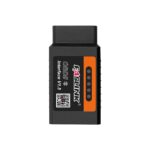Understanding the history of On-Board Diagnostics (OBD) and specifically when OBD2 started is crucial for anyone working with modern vehicles. This article explores the evolution of OBD, highlighting key milestones and the significance of the OBD2 standard.
The Genesis of On-Board Diagnostics
The concept of on-board diagnostics dates back to the 1960s, with Volkswagen introducing the first OBD system with scanning capabilities in 1968. Early OBD systems were rudimentary and lacked standardization. Each manufacturer developed proprietary systems, leading to compatibility issues and challenges for repair technicians.
The Standardization of OBD: The Road to OBD2
The need for a standardized approach to vehicle diagnostics became increasingly apparent. Organizations like the California Air Resources Board (CARB), the Society of Automotive Engineers (SAE), and the Environmental Protection Agency (EPA) played pivotal roles in pushing for standardization.
In 1991, California mandated that all vehicles sold in the state have a basic form of on-board diagnostics, known as OBD I. This was a significant step, but true standardization arrived with OBD2.
OBD2 Year Start: 1996 in the United States
The Obd2 Year Start was 1996 in the United States. California’s mandate requiring all 1996 model year vehicles to be equipped with OBD2 paved the way for nationwide adoption. This standardization revolutionized vehicle diagnostics and repair. OBD2 provided a universal connector, standardized diagnostic trouble codes (DTCs), and access to critical vehicle data.
OBD2’s Global Impact
The impact of OBD2 extended beyond the United States. In 2001, the European Union mandated EOBD, the European version of OBD2, for all gasoline vehicles. Diesel vehicles followed suit in 2003. This global adoption solidified OBD2 as the industry standard.
OBD2 and Beyond: WWH-OBD
While OBD2 remains the prevalent standard, the evolution of on-board diagnostics continues. WWH-OBD (World Wide Harmonized On-Board Diagnostics) represents the next generation, offering expanded data access and more detailed fault information. WWH-OBD builds upon the foundation laid by OBD2, incorporating elements of Unified Diagnostic Services (UDS) to provide richer diagnostic capabilities.
Conclusion
The OBD2 year start marked a turning point in the automotive industry. Standardization through OBD2 simplified vehicle diagnostics, enabling more efficient repairs and improved emissions monitoring. As vehicle technology advances, WWH-OBD is poised to further enhance diagnostic capabilities, ensuring that on-board diagnostics continue to play a crucial role in the automotive landscape.

